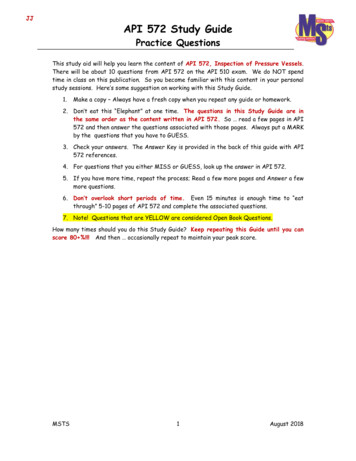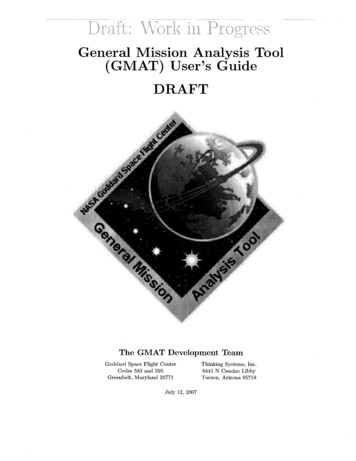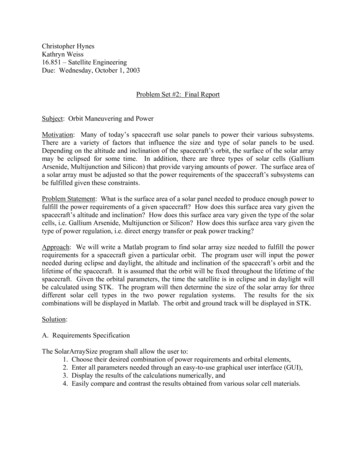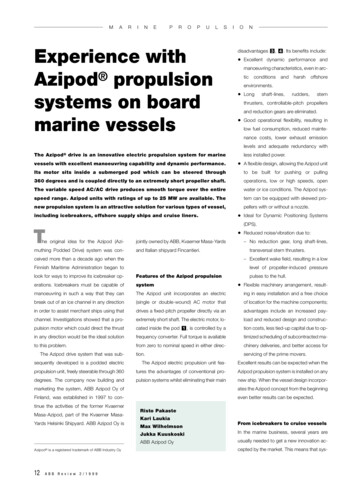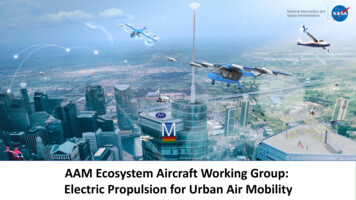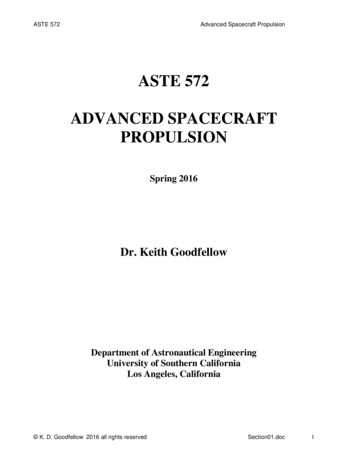
Transcription
ASTE 572Advanced Spacecraft PropulsionASTE 572ADVANCED SPACECRAFTPROPULSIONSpring 2016Dr. Keith GoodfellowDepartment of Astronautical EngineeringUniversity of Southern CaliforniaLos Angeles, California K. D. Goodfellow 2016 all rights reservedSection01.doc1
ASTE 572Advanced Spacecraft PropulsionASTE 572 Advanced Spacecraft PropulsionSpring 2016 ScheduleFridayDate5:10 – 7:50 P.M.DEN Remote Broadcast and OHE 114 classroomSubjectBook1/15 Organization of the class. Definitions. Intro. to advancedHP2 Chap. 10,propulsion.Jahn chap. 11/22 Mission V and orbital mechanics. Review of rockets. System HP2 Chap. 10,Jahn chap. 1sizing.1/29 Review of thermodynamics and compressible gas dynamics.HP2 Chap. 32/5 Review of thermal rockets. Heat transfer.HP2 Chap. 112/12 Heat transfer, Power systems. Nuclear reactions. NuclearHP1 chap. 15thermal rockets.2/19 Nuclear reactions. Nuclear thermal rockets. Solar & Nuclear JPL notes, NASAelectric propulsion systems.NTR notes2/26 Electromagnetic theory: electric charges and fields, currents,HP1 chap. 5and magnetic fields, and applications to ionized gases.Jahn chap. 23/4 Ionization. Introduction to rarified gases. Charged particleJahn chaps. 4 andmotion. Introduction to plasma physics. Electrode phenomena.5, V&K,HP1 chap. 53/11 MIDTERM EXAM, in class, 1.5 hours3/18 Spring Break3/25 Introduction to arc discharges.Jahn chap. 64/1 Electrothermal acceleration: 1-D model and frozen flowJahn chap. 6, JPLlosses. Resistojet thrusters. Arcjet thrusters.notes4/8 Electrostatic acceleration: 1-D space charge model, ionJahn chap. 7thrusters, ion production, beam optics, beam neutralization.HP1 chap. 16 JPLOther thrusters.notes4/15 Electromagnetic acceleration: MHD channel flow;Jahn chap. 8Magnetoplasmadynamic (MPD) thrusters, description andHP1 chap. 16thrust derivation, operating limits, and performanceJPL notescalculation.4/22 Hall Current Thrusters (HCT): physics and technology.Jahn chap. 9Unsteady electromagnetic acceleration: pulsed plasma thrusterJPL notes(PPT). (HCT special guest lecture by Justin Pucci)4/29 Overview of advanced concepts. Sails, beamed energy, fusion JPL APC Notespropulsion, antimatter propulsion. Interstellar missionsSpecial topics: micro-propulsion, tethers, piloted Marsmission, other class-selected topics.3 UnitsNotesHW due12*3,4,56, 7812384TBD5TBD6paperapprovalsdueTBD97899910911and paperreviews due12(reistojetdesignproject)May 6 Final Exam 4:30 – 6:30 in classHP1 Hill and Peterson 1st ed. (copies on class DEN web site )HP2 Hill and Peterson 2nd ed.V&K Intro to Physical Gas Dynamics, Vincenti and Kruger (copies on class DEN web site)* Class survey, email addresses, and obtain additional needed materials for unfamiliar topics. K. D. Goodfellow 2016 all rights reservedSection01.doc2
ASTE 572Advanced Spacecraft PropulsionThe first half of the course focusses on fundamentals and some systems level concepts (nuclear andpower). We quickly review rocket basics, orbital mechanics, thermodynamics and compressible gasdynamics topics that are covered in ASTE 470. Additional introductory material on nuclear physics,rarefied gases, and plasma physics is covered. The second half of the class focuses on electricthruster characteristics (electrostatic, electrothermal and electromagnetic acceleration).Instructor:Dr. Keith Goodfellowemail: preferred keith.goodfellow@usc.eduCommunication by email is welcome and encouraged. It is reliable as well as providing a savedtranscript.This class is being taught off campus through the DEN system using WebEx. Tuning in to the livelectures is strongly encouraged, since it enables students to ask questions and bring up topics fordiscussion. A classroom/studio will be available on campus so students attend the lectures together.TA: To be announcedPrerequisite: ASTE 470 (formerly AME 473) Spacecraft Propulsion or equivalent. You should befamiliar with rocket performance, simple orbital mechanics (such as Hohmann transfer),compressible gas dynamics and nozzles, and basic heat transfer. We will quickly review theseareas.Required Text:Physics of Electric Propulsion, Robert Jahn, McGraw-Hill, 1968.Reprint in paperback from Dover Publications (2006), ISBN 0- 486-45040-6, about 15 - 25 fromseveral online book stores. (about 22 at Amazon.com)Recommended Text:Mechanics and Thermodynamics of Propulsion 2nd ed., P. Hill and C. Peterson, Addison-WesleyPublishing Company, 1992 ISBN 0-201-14659-2. (same text as ASTE 470) An excellent bookcovering the fundamentals of propulsion. It covers both rockets and air-breathing. Not as muchdetails on rockets as the following 3 textbooks, but it is a better textbook for fundamentals. Thiswas the required text for this class for ASTE 470 for 18 years.Additional References:1. Rocket Propulsion Elements 8th ed., G. P. Sutton and O. Biblarz, John Wiley & Sons, 2001.An excellent book for the fundamentals of variety of chemical rocket elements (propellants, feedsystem layouts, thrust vectoring, etc.). The 7th and 8th editions are much better than the previouseditions. K. D. Goodfellow 2016 all rights reservedSection01.doc3
ASTE 572Advanced Spacecraft Propulsion2. Space Propulsion Analysis and Design, R. W. Humble, G. N. Henry and W. J. Larson, McGrawHill Inc, 1995.This book focuses more on the design methodologies of spacecraft propulsion systems and missionsrather than on the fundamentals. It covers chemical, electric and nuclear systems.3. Introduction to Physical Gas Dynamics, W. G. Vincenti and C. H. Kruger, Krieger Publishing,1986.Good book for molecular gas dynamics, statistical thermodynamics and real gas properties. Was outof print but has been recently reprinted.4. Partially Ionized Plasmas, M. Mitchner and C. H. Kruger, John Wiley and Sons, 1974.Excellent book for plasmas, lots of details. Out of print but copies are available on web.5. Introduction to Plasma Physics and Controlled Fusion 2nd ed., F. F. Chen, Plenum Press, 1985.Excellent introductory book for plasmas.6. Fundamentals of Plasma Physics 3rd ed., J.A. Bittencourt, Springer Publishing , 2004. Excellentintroductory book for plasmas.7. Any Sufficiently Advanced Technology is Indistinguishable from Magic, R. L. Forward, BaenPublishing 1995.An excellent combination of science fact and science fiction on advanced propulsion. Paperback(about 6).History Books of Interest:1. M. Gruntman, Blazing the Trail, The early History of Spacecraft and Rocketry, AIAA, 2004,ISBN 1-56347-705-X.An excellent book on the history of the field. Unique in its coverage of both the US and Sovietprograms2. J. Dewar, To the End of the Solar System, The Story of the Nuclear Rocket, The University Pressof Kentucky, 2004, ISBN 0-8131-2267-8.An excellent book covering the history of the nuclear thermal rocket program. Both the technologyand the politics.Book to Avoid:Martin Tajmar, Advanced Space Propulsion Systems, Springer /Wien, New York. 2003. A 130page paperback book that has less material in it than the JPL notes that will handed out in class. Itsells for about 60 (it did sell for 80) but should sell for 10.Hand-Outs. Will consist of homework assignments and notes that are essential and mandatory tothe course. Course notes, homework assignments and homework solutions will be posted on theDEN ASTE 572 Web site. The DEN home page is: https://courses.uscden.net/d2l/login Our classsite will contain the notes for each lecture, the homework assignments, the homework and examsolutions, and the annotated lecture notes from each class. The notes we will be using for eachlecture will be posted prior to class. Please bring a copy to class. We will be annotating those notesplus including additional material in each lecture. At the end of each lecture I will post theannotated lecture notes. You can download these notes if you miss anything during the lecture. K. D. Goodfellow 2016 all rights reservedSection01.doc4
ASTE 572Advanced Spacecraft PropulsionThey are usually posted the day after our class. The class web site is available to both on-campusand off-campus students. Everyone should have an account.Additional course material will also be provided in PDF format on the class Distance EducationNetwork (DEN) web site. These will include review material from ASTE 470, copies of materialfrom out of print texts, and material from the advanced propulsion systems notebooks prepared bythe JPL Advanced Propulsion Technology group over the last two decades. The JPL notes wereavailable online for several years but were removed around 2003. We will cover portions of thesematerials, but the entire contents are posted so you can use them for reference.Class Procedure: Teaching will be done directly from the notes and additional in class notes. It isadvisable to review the appropriate material before the lecture and bring the appropriate material toclass.Discussion Forum on DEN site. The DEN ASTE 572 web site has discussion forums in the areasof class lectures, homework and areas of interest. This is a good place to ask clarification questionson the lectures or homework that would be of interest to everyone. Please do not post solutions andkeep it professional. Violators will be removed from the forum. Areas of Interest could beanything you think the rest of the class would be interested in or questions you may have.Homework: As scheduled. One homework score (30 points) will be dropped for a total of 11recorded scores. Problem set 12 (resistojet design) is worth 90 points. The homework is worth 30%of the total grade and the exam questions are often based on the homework. Therefore, if you fail todo the homework, it is unlikely you will receive a good grade for the course. Extra credit problemsmay be given at times. No other “special” problems, projects, or extra work will be given.Homework is due at class time on the specified date. Homework is considered late if receivedafter 9:00 AM on morning after class (Monday morning). Homework can be left in our classmailbox (outside Prof. Erwin’s office) before class or get it directly to the TA. It is yourresponsibility to get it to the TA. Do not leave late homework in one of the mailboxes since wewon’t know when it was turned in. Late homework can be submitted up to one week after the duedate and will be graded and reduced by a 50% factor. No homework will be accepted after thehomework has been returned or the solutions have been posted. If you have grading questionsplease call of see the TA first and then contact the instructor if there is still a problem. TheResistojet project is due on the assigned date (last class) and will not be accepted after that date.Students are encouraged to work together and share ideas but each student must turn in their ownwork. Plagiarism, either from another’s work or from previous homework solutions will not beallowed and will result in loss of credit for the assignment. Repeat offenders may be dropped fromthe course and expelled from the department.If you are a distant student and would like to know if there are others in your region, let me know. Iwill provide a local contact list for anyone wanting it. Your contact information will not be sharedto others without your written approval (email).Paper Review: Each student will write a one-page review of a student selected technicalpublication. Papers may be on any topic related to the course. (electric propulsion, nuclearpropulsion, advanced concepts, etc.) The paper must be a technical conference or journal K. D. Goodfellow 2016 all rights reservedSection01.doc5
ASTE 572Advanced Spacecraft Propulsionpublications and be at least 5 pages long. A Powerpoint presentation will not be accepted as atechnical paper. This will count as one homework assignment. Students are encouraged to pick atopic of personal or professional interest. Each student will submit a paper (or selection of papers)for approval on or before March 25 (midterm exam) for 5 points. Final paper reviews are due onApril 22 (25 points).Each review should address the following in one page:What is the paper about?Why is this topic important?Is it good work or not? Why?Your overall impression of the work and its relevance.Good sources for papers are: American Institute of Aeronautics and Astronautics (AIAA) Journal ofPropulsion and Power and the AIAA Journal of Spacecraft and Rockets. However, the best sourcesfor papers are the annual AIAA Joint Propulsion Conference (held June or July each year) and theInternational Electric Propulsion Conference (IEPC) (held alternating years.) Prior to 1993 AIAAco-hosted the IEPC conferences and these papers have AIAA assigned paper numbers, and can beobtained through AIAA. After 1993 the papers have an IEPC number and can be obtained throughthe Electric Rocket Propulsion Society (ERPS). http://erps.spacegrant.org/index.php?page iepcdownload-88-07Typically, there are 200 papers presented at these conferences each year on the topics of electricand advanced propulsion while only a few papers will be in the journals. Other possible journals ofinterest are the IEEE Transactions in Plasma Science, and the Physics of Fluids. The paper must bea full paper ( 3 pages long) not a “technical note.”Paper format: 1 page, 10 or 12 point font, single spaced, 1 inch margins. Include title, authors,publisher (journal or conference) and date.Resistojet Thruster Design Project: The last homework assignment (HW 12) will consist of aresistojet thruster design project. It is worth three times as many points a normal assignment (90points). Each student will select an application (orbit transfer, station keeping, etc.) and design athruster for that application. The design will include the heating mechanism, nozzle and thermalanalysis. More details and the assignment will be given later (Usually after the heat transferlectures).Exams:Midterm exam:Final exam:Friday, March 11, 5:10 – 7:50 PM. Class time, Location TBDFriday, May 6, 4:30 – 6:30 P.M. Location TBDExams are closed book and closed notes. One 8 ½ inch by 11 inch sheet of notes (both sides) isallowed for the Midterm exam and 2 sheets are allowed for the Final exam.Make-up Exams: Make-exams will be given only for special circumstances. Make-up exams willbe more difficult than the regular exams.Grading:HomeworkMidtermFinal 30% 30% 40%Attendance: Up to you. We will not be keeping track. K. D. Goodfellow 2016 all rights reservedSection01.doc6
ASTE 572Advanced Spacecraft PropulsionReligious Holy Days: Please arrange in advance to make up work missed on those days.Questions: Discussion is always welcome and encouraged on all aspects of astronautics and spaceexplorations as well as on the topic at hand. Given the wide variety of topics in this class, there arefew areas of spacecraft propulsion or power (including your favorite sci-fi vehicles) that would beconsidered “off topic.”Biography:Keith Goodfellow, Chief Engineer, Arcjet Thruster System, Aerojet Rocketdyne Space Systems,Redmond, WAKeith Goodfellow got his B.S. in mechanical engineering with a minor in physics from theUniversity of Utah in 1986 and his M.S. in mechanical engineering from Purdue University in 1988.At Purdue his pursued coarse-work in solid and liquid propellant rockets, hypersonic aerodynamicsand performed research on electric propulsion thrusters and plasma physics. He received his Ph.D.in aerospace engineering from USC in 1996. His work was on the interactions of plasma-arcdischarges and electrodes in electric propulsion thrusters. He was a member of the AdvancedPropulsion Technology Group at the Jet Propulsion Laboratory (JPL) from 1988 until 2004. At JPLhe was involved with the performance and endurance testing of many different types of electricthrusters (arcjet thrusters, Hall thrusters, ion engines, MagnetoPlasmaDynamic (MPD) thrusters,and innovative thrusters), plasma diagnostics, facility and data acquisition system development,evaluation of advanced propulsion concepts, development and testing of solar and microwavedriven sails, mission studies, spacecraft design, spacecraft thermal and vacuum testing, and flightoperations support (Deep Space One). He was a member of the American Institute of Aeronauticsand Astronautics (AIAA) Electric Propulsion Technical Committee for 5 years. At the LockheedMartin Advanced Development Programs (Skunk Works) from 2004 to 2013 he was a member ofthe Revolutionary Technology Programs group and performed research and development work inpropulsion systems, plasma devices, advanced materials, and vehicle conceptual design. He iscurrently the Chief Engineer of the Arcjet Thruster System (thruster and Power Conditioning Unit(power electronics box)) for Aerojet Rocketdyne in Redmond, WA. He has been developing andteaching courses at USC since January 2000. He codeveloped and taught ASTE 470 SpacecraftPropulsion and ASTE 280 Introduction to Astronautics and the Space Environment; and developedand teaches ASTE 572 Advanced Spacecraft Propulsion. K. D. Goodfellow 2016 all rights reservedSection01.doc7
Physics of Electric Propulsion, Robert Jahn, McGraw-Hill, 1968. Reprint in paperback from Dover Publications (2006), ISBN 0- 486-45040-6, about 15 - 25 from several online book stores. (about 22 at Amazon.com) Recommended Text: Mechanics and Thermodynamics of Propulsion 2nd ed., P. Hill and C. Peterson, Addison-Wesley
